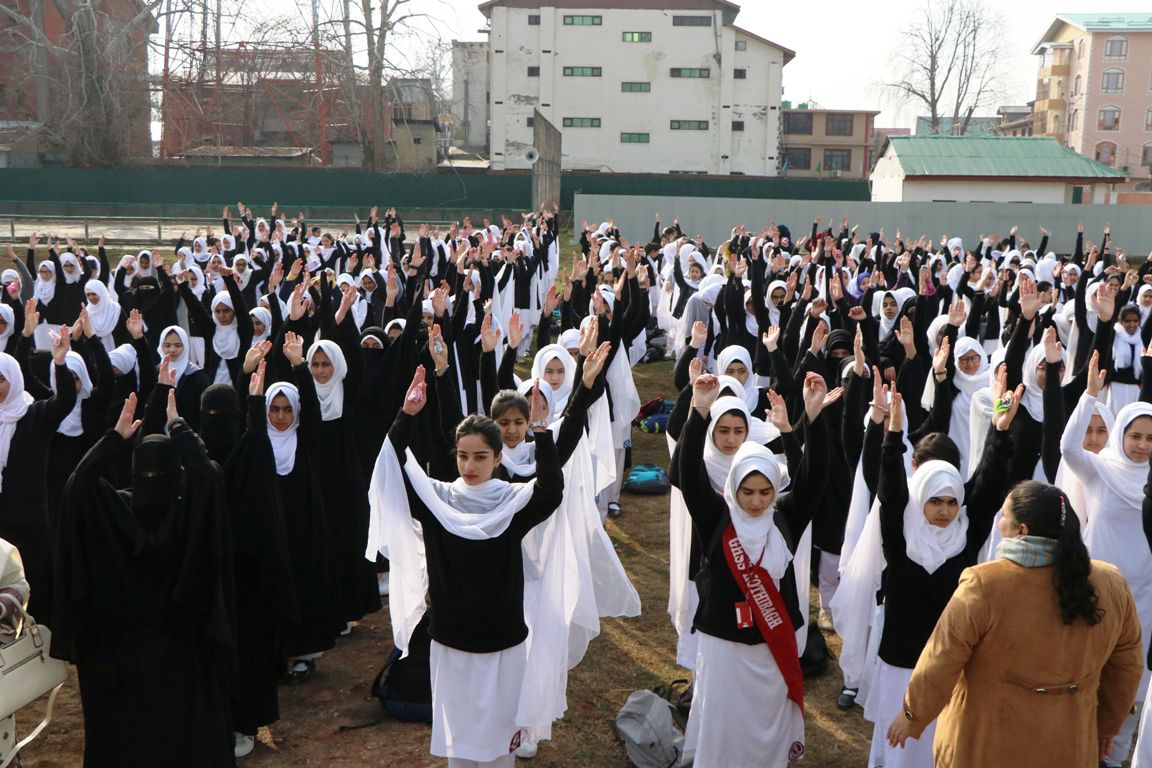In a world besieged by the virus, people are working from their homes, using the high-speed Internet. In Kashmir, more than 1.5 million students are seeking better connectivity to keep the life going. In absence of it, some young boys and girls are innovating to get the students to virtual classrooms, reports Farzana Nisar

On a sunny March afternoon, Mujtaba Bilal, a tenth class student cycles in the grassy front yard of his house in Kulgam. His mother, Nuzhat Jan repeatedly calls him inside to study. “You are playing since morning. Please come inside and study for a while,” shouts Nuzhat. Paying no heed to his mother, Mujtaba continues to glide on the pathways that surround the yard.
Just weeks ago, Mujtaba along with million other students in Kashmir had attended his classes for the first time in almost seven months. The situation that had emerged post-August 5 and the subsequent winter vacations had halted the smooth functioning of schools in Kashmir. But now when the outbreak of deadly Covid-19 has forced authorities to announce the closure of schools, students are once again restricted to their homes.
In the wake of this pandemic, students in other parts of the world have shifted to virtual classrooms; the lack of online learning platforms in the valley can take a heavy toll on education.
“Back in August, there was a complete communication blockade in Kashmir but today the presence of proper digital infrastructure could have helped a lot. It is the best alternative to offline classes,” said Nuzhat. “My son doesn’t listen to anyone when asked to read. Schools should make online lessons to keep children busy with studies these days.”
Not just the parents of school-going children, the need for ed-tech platforms is also felt by college and university students who earlier lost their academic session to 2019 lockdowns.
“While much harm has been done by the earlier unrests in Kashmir, the technology-enabled forms of learning could prove to be a saviour. We already lost our entire semester to recent shutdowns and would not like that to happen again,” said Toiba Bashir, a post-graduate student at the University of Kashmir. “We know that our institutions are not digitally that advanced but e-learning should be on their priority list now. All our teachers have to do is to record the lectures and post them.”
Efforts by Academicians
Concurring that online learning is a second substitute to in-person delivery, a number of professors from different colleges of Kashmir have turned to Google classrooms to teach their students. Dr Irshad A Wani, Assistant Professor Chemistry at Government Degree College Anantnag took to social networking site Facebook and said, “We have started a series of classes on Google classroom for the on-going CBSC BG second semester in Chemistry. Kindly communicate the message to the students in your vicinity so as to assure the maximum participation of students.”
Hailing such efforts students believe that more and more teachers should start teaching them online. “Following the instructions of our principal, teachers of different departments are making use of Google classrooms to reach out to students. Our teachers have started to upload PowerPoint presentations and it will save us a lot of precious time,” said Saif Bhat, a student of Cluster University, Srinagar. “All other educational institutions should start the online teaching process as soon as possible,” he added.
The Directorate of School Education Kashmir also said that it is making efforts to engage teachers for online lessons. Director DSEK, Mohammad Younis Malik said that the department has found onscreen classes as the only option to compensate for the academic losses of the student. “We are looking forward to engaging skilled teachers to deliver on-screen lessons through Doordarshan channels and other cable networks,” Malik said.

Moreover, the Department of School Education J&K in association with Radio Mirchi has started Mirchi master class radio learning project for students from ninth to twelfth classes. Arun Manhas, State Project Director, Samagra Shiksha, J&K informed the students that they can access the e-content and e-books of NCERT by using DIKSHA App (Digital Infrastructure for Knowledge Sharing).
Education Multimedia Research Centre (EMMRC), University of Kashmir also urged students to use the digital platform provided by the Consortium for Educational Communication in collaboration with them. In a statement issued by the Director EMMRC, KU, Dr Shahid Rasool said, “While being at home the students could connect with the CEC digital platforms for the courseware available.” He said these channels are free to air and can be accessed through your cable operator. The statement further reads that UG and PG MOOC’s (Massive Open Online Courses), which were earlier delivered on SWAYAM platform, are being archived and may be accessed by any learner.
Need for Internet
Nevertheless, the students want the availability of high-speed Internet to access educational content online. “We already lack local e-learning platforms in Kashmir and whatever little is available we cannot even download that on such a low speed. How can we watch video lectures on YouTube without 4G? If students don’t have access to 4G, their value is useless,” said Adnan, an undergrad student.
Saqlain Mushtaq, a student of Aligarh Muslim University, who has returned to Kashmir amid coronavirus scare said that his university has decided to upload the e-content including video lectures through education portals like SWAYAM. “But here in Kashmir I will not be able to benefit from it,” he said.
Mudasir Nazar, an engineering graduate, said that education has always been the biggest casualty in Kashmir and the government is largely responsible for it. “Today when, in the rest of the world, students are learning from home using online tools, we in Kashmir struggle with throttled 2G internet,” he said.
“Moreover, if the school education department is mulling televised classes, I do not expect it to be that big a success. It will be too little, too late,” he added.
Digital Divide
While some private institutions in the Srinagar city and other major towns are exploring the academic cyberspace to deliver lessons to their students, most of the rural schools are not as equipped.
Delhi Public School, Srinagar has opened up its content library for the students on YouTube, where the video lectures are available online. “It is good to see that the lectures are well sorted according to the classes and subjects. It seems as if we attend our regular classes daily while sitting in our homes,” said Mehak, a student of DPS. Likewise, SRM Welkin Higher Secondary School, Sopore is also uploading lectures on YouTube to benefit its students. Some other schools have started sending assignments to the students through e-mails.

However, many schools in rural areas lack the technology, teacher training and in some cases internet access too to deliver such lessons. “Schools in villages lag behind. They can’t create online learning sites for their students. Although there is a mass availability of educational content on the Internet lectures by respective teachers can keep students interested. They realize the seriousness of the matter only when they see it coming from someone who teaches in their school,” said Aadil Ahmad, a resident of Damhal village in Kulgam.
“My daughter reads in a local village school. They don’t even have my email address, how can I expect them to create online lessons,” he added.
Volunteer Initiatives
Being used to the months-long unrests and shutdowns, volunteers from Kashmir have time and again proved to be the saviours in times of distress. Internet or no Internet, they have always responded when Kashmiris were in need. Post-August 5, as education suffered, people set up community tuition centres to help the students and today once again volunteers have come up with ideas to keep students busy with books.
Sajid Khan, a young boy in his twenties from Manjgrah village in Baramulla has started an initiative to teach students of Kashmir online. A journalism graduate from Chandigarh, Sajid with the help of local educated boys have decided to deliver free online YouTube classes for sixth to tenth classes. “In these times when personal tuitions are not an option, I thought it is better to utilize my YouTube channel Kashmir Now to deliver online lessons. Many people have turned up for the cause and we now are a team of 10 people,” said Sajid.
Coronavirus: As Epidemic Looms Large, Kashmir’s 4G Desperation Surges
Umeed Coaching Centre Sheeri, a local coaching institute has volunteered to participate and support their initiative. “They have provided us with their classrooms where we can deliver the lecture to be recorded.” Censuring the low-speed internet, Sajid said that it took him hours to upload the video content online.
In Shangergund area of north Kashmir’s Sopore, Aabid Sofi, a recent tenth class pass out from JNV (Jawahar Navodaya Vidyalaya ) Baramulla is busy in making time table for his free online class website. As coronavirus shut down schools, Aabid also created an online platform, Blooming Dales for students to learn. Unlike other YouTube classes, he initiated more of an online webinar, where students through live chats can ask questions and pose queries. “We have a mass of video lectures available online, but what they lack is teacher-student interaction. So I decided to build a platform where both teachers and students can come forward to create much of a classroom type of atmosphere,” Aabid said. “This platform provides video lectures, quizzes, monthly exam, discussion and debates. We also keep track of student’s activities in addition to parental contact. All the students have to do is sign up and enter the access code given to them.”
Being a student himself, Aabid is desirous of getting benefited from his own initiative as qualified people from all over the valley have volunteered to teach in these classes. “Because of my inclination towards technology, I with the help of some of the friends was able to start the website. I cannot teach myself but more than 30 experienced teachers have joined us.”
Earlier, Aabid had started an online learning platform, e-class but owing to the low-speed Internet in the valley it couldn’t function well. “Due to 2G, teachers, as well as students, were not able to access it properly. So, I created Blooming Dales, which is light as compared to the previous one.”















